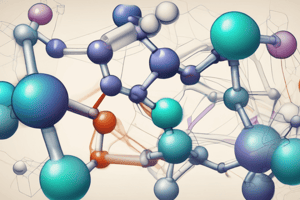Podcast
Questions and Answers
What is the name of the vitamin obtained from the oxidation of nicotine?
What is the name of the vitamin obtained from the oxidation of nicotine?
- Vitamin B3 (correct)
- Vitamin B5
- Vitamin B6
- Vitamin B1
What is the name of the reaction that produces a symmetrically substituted 1,4-dihydropyridine?
What is the name of the reaction that produces a symmetrically substituted 1,4-dihydropyridine?
- Alkyl Pyridine Synthesis
- Dicarbonyl Synthesis
- Hantzsch Synthesis (correct)
- Nicotinic Acid Synthesis
What is the common name for trimethylpyridines?
What is the common name for trimethylpyridines?
- Collidines (correct)
- Nicotines
- Lutidines
- Picolines
What is the product of the reaction between NH3 and an aldehyde with two molecules of 1,3-dicarbonyl compound?
What is the product of the reaction between NH3 and an aldehyde with two molecules of 1,3-dicarbonyl compound?
What is the name of the acid used in the treatment of tuberculosis?
What is the name of the acid used in the treatment of tuberculosis?
What is the limitation of the synthesis of pyridines from 1,5-dicarbonyl compounds?
What is the limitation of the synthesis of pyridines from 1,5-dicarbonyl compounds?
What is the name of the disease that nicotinic acid is used to prevent?
What is the name of the disease that nicotinic acid is used to prevent?
What is the common name for monomethylpyridines?
What is the common name for monomethylpyridines?
What is the starting material for the synthesis of pyridines using the Hantzsch synthesis?
What is the starting material for the synthesis of pyridines using the Hantzsch synthesis?
Flashcards are hidden until you start studying
Study Notes
Pyridine and Pyridine Derivatives
- Pyridine (C5H5N) is the heterocyclic analogue of benzene (C6H6), derived by substituting -CH= with -N=.
- Pyridine is an aromatic heterocycle, characterized by:
- Stability
- Reacting by substitution
- Deshielded ring H's in the NMR spectrum (δ= 6.8-8.5ppm)
Importance of Pyridine
- Pyridine plays a key role in several biological processes, such as:
- The oxidation/reduction coenzyme NAD
- Pyridoxine (Vitamin B6)
- Pyridine exists in several alkaloids, e.g., nicotine
- It also exists in many synthetic drugs, e.g., Pantoprazole sodium
Resonance of Pyridine
- The N atom has –I effect via σ bond and -M effect via π bond
- Contributing structures:
-
- (δ+)
- A, B, C, D, E, and Hybrid structures
Chemical Reactions of Pyridine
- Basic properties:
- Pyridine is basic due to the electron pair on nitrogen (N:)
- Less basic than corresponding aliphatic amines (e.g., piperidine)
- Reactivity:
- Decreased reactivity to SE reactions
- Increased reactivity to SN reactions
- Easier reduction
- Resistance to oxidation reactions
- Increased reactivity of methyl groups at 2-, 4-, and 6-positions
Basic Properties of Pyridine
- Pyridine reacts with acids to give stable salts
- Pyridine is a useful solvent due to:
- Polarity
- Ability to catalyze reactions involving acid elimination
- Miscibility with water and organic solvents
- Alkylation and acylation at nitrogen:
- Formation of quaternary pyridinium salts
- Reaction with percarboxylic acid to form pyridine -N-oxide
Electrophilic Substitution (SE) in Pyridine
- Unreactive to SE reactions due to:
- Electron withdrawing (-M and -I) effects of the ring N
- Destabilization of the intermediate σ-complex by the -I effect of the N atom
- Rapid formation of pyridinium cation, which is resistant to further SE reaction
- Orientation of SE:
- Reaction occurs at position 3- or 5- (β-position) due to the least disfavored σ-complex
Nucleophilic Substitution (SN) in Pyridine
- Favored SN reactions occur at C2, C4, and C6 due to:
- Electron deficiency at these positions
- Stabilization of the intermediate anion by resonance
- Direct Nucleophilic Substitution:
- Reaction with nucleophiles, e.g., Br and NH2
Reaction of Pyridine with Reducing Agents
- Pyridines are easily reduced, e.g., with reducing agents
Reaction of Pyridine with Oxidizing Agents
- Pyridines are resistant to oxidation, but more rapidly oxidized in alkaline media than in acidic solution
Pyridine Derivatives
- Alkyl pyridines:
- Monomethyl pyridines (picolines)
- Dimethylpyridines (lutidines)
- Trimethylpyridines (collidines)
- Pharmaceutical applications:
- Nicotinic acid (Vitamin B3)
- Isonicotinic acid (used in the treatment of tuberculosis)
Synthesis of Pyridine
- Two approaches:
- From 1,5-dicarbonyl compounds
- Hantzsch synthesis (involves the reaction of NH3 with an aldehyde and two molecules of 1,3-dicarbonyl compound)
Studying That Suits You
Use AI to generate personalized quizzes and flashcards to suit your learning preferences.




